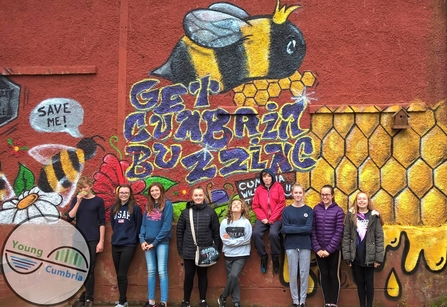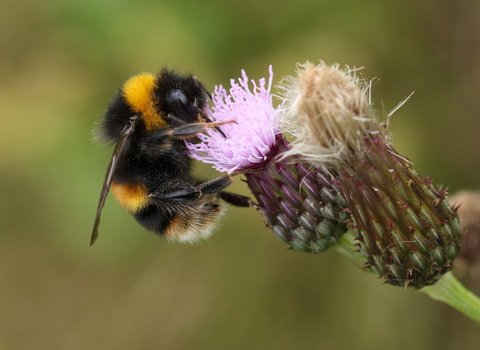Our wild pollinators are in trouble. More than half of UK bee, butterfly and moth species have declined in the past 50 years, and 30 species of bee face extinction. Over the last 75 years we’ve lost 97% of our flower rich meadows, 50% of our hedgerows, and 60% of flowering plants are in decline.
This is largely due to the intensification of agriculture, the increased urbanisation of our villages, towns and cities, and the construction and expansion of major road networks. Much of the remaining flower rich habitat on which our pollinators depend is now seriously fragmented or degraded. To combat this loss, Cumbria Wildlife Trust is working with local communities, and has joined forces with Highways England and a wide range of partners to take action for pollinators across northwest Cumbria.

A group of eight young people in Workington transformed the plain walls of a sports changing room on the edge of their local football pitch into a riot of colour, to celebrate bees. © Young Cumbria
Partners in the project include: Copeland Borough Council, Allerdale Borough Council, Solway Coast Area of Outstanding Natural Beauty, Butterfly Conservation, Buglife, Cumbria Biodiversity Centre, Highways England, Workington Nature Partnership, National Trust and Florence Arts Centre. Together, they will create 115 hectares of wildflower rich habitat across northwest Cumbria to help boost pollinators - that's an area half the size of Maryport.
They plan to create pollinator friendly havens at 62 sites in northwest Cumbria along pollinator pathways known as ‘B-lines’. Researched and mapped by Buglife, B-Lines are a series of ‘best fit’ pathways that run through our towns and countryside and have the potential to link fragmented habitats. This project aims to provide vital stepping stones of flower rich habitat. These stepping stones will enable our wild pollinators to move freely along the B-lines network across northwest Cumbria.

Map showing scale of Get Cumbria Buzzing project

Migrant hoverfly ©Ross Hoddinott/2020VISION

